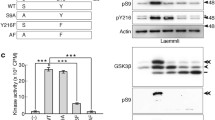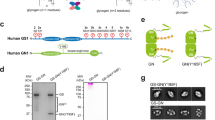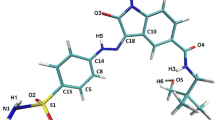Abstract
Several peptides derived from microtubule-associated tau protein, have been tested as substrates for glycogen synthase kinase 3 (GSK 3). In the absence of cofactors, GSK 3 can modify serines or threonines followed by prolines. In other cases, a phosphorylation in position +4 is required for the phosphorylation of threonine/serine residues. A third type of substrate can be modified by GSK 3 in the presence of heparin. The comparison of GSK 3 with other kinases suggests some similar features of this kinase with proline-directed protein kinases, such as cdc-2 or mitogen-activated protein kinase (MAP Kinases) and also with casein kinase 2 (CK 2). Thus, all these kinases are specifically inhibited by 5,6-Dichloro-1-β-D-ribofuranosyl)-benzimidazole (DRB). However, heparin is an inhibitor of CK 2 whereas it activates the modification of certain substrates by GSK 3. A possible explanation for the obtained results is that the consensus sequence for GSK 3 phosphorylation is a serine/ threonine adjacent to a proline or other β-turn former residue and that such recognition could be favoured by the presence of adjacent negative charges or the addition of polyanions.
Similar content being viewed by others
Abbreviations
- GSK 3:
-
glycogen synthase kinase 3
- PDPK:
-
proline-directed protein kinase
- DRB:
-
5,6-Dichloro-1-β-Dribofuranosyl)benzimidazole
References
Embi N, Rilatt DB, Cohen PC: Glycogen synthase kinase 3 from rabbit skeletal muscle. Separation from cyclic AMP-dependent protein kinase and phosphorylase kinase. Ear J Biochem 107: 519–527, 1980
Hemmings BA, Yellowlees D, Kernohan JC, Cohen P: Purification of gllycogen synthase kinase 3 from rabbit skeletal muscle, copurification with the activating factor (Fa) of (Mg-ATP)-dependent protein phosphatase. Ear J Biochem 119: 443–451, 1981
Parker PJ, Candwell FB, Cohen P: Glycogen synthase from rabbit muscle: Effect of insulin on the state of phosphorylation of the seven phosphoserine residues in vivo. Ear J Biochem 130: 227–234, 1983
Poulter PJ, Ang SG, Gibson BW, Williams DH, Homes CFB, Candwell FB, Pitcher J, Cohen P: Analysis of the in vivo phosphorylation state of rabbit skeletal muscle glycogen synthase by fast-atom-bombardment mass spectromy. Ear J Biochem 175: 497–510, 1988
Woodgett JR: Molecular cloning and expression of glycogen synthase kinase-3/Factor A. EMBO J 9: 2431–2438, 1990
Takahashi M, Tomizawa K, Kato R, Sato K, Uchida T, Fujita SC, Imahori K: Localization and developmental changes of tau protein kinase I/GSK-3β. J Neurochem 63: 245–255
Hemmings BA, Aitken A, Cohen P, Rymond M, Hofmann F: Phosphorylation of type-II regulatory subunit of cyclic AMP-dependent protein kinase by glycogen synthase kinase 3 and glycogen synthase kinase 5. Eur J Biochem 127: 473–481, 1982
Vandenheede JR, Yang S-D, Goris J, Merlevede WC: ATP Mg-dependent protein phosphatase from rabbit muscle. Purification of the activating factor and its regulation as a bifunctional protein also displaying synthase kinase activity. J Biol Chem 255: 11768–11774, 1980
Boyle WB, Smeal T, Defize LH, Angel P, Woodgett JR, Karin M, Hunter T: Activation of protein kinase C decrease phosphorylation of cjun at sites that negatively regulate its DNA-binding activity. Cell 64: 573–584, 1991
Fiol C, Williams JS., Chou CH, Wang OM, Roach PJ, Adnisani O: A secondary phosphorylation of CREB341 at Ser129 is required for the cAMP-mediated control of gene expression. J Biol Chem 269: 32187–32193, 1994
Perrimon, N: The genetic basis of patterned baldness in drosophila. Cell 76, 781–784, 1994
He X, Saint-Jeannet JP, Woodgett JR, Varmus HE., Dawid, IB: Glycogen synthase kinase 3 and dorsoventral patterning in Xenopus embrios. Nature 374: 617–622, 1995
Hanger DP, Hughes K, Woodgett JR, Brion J-P, Anderton, BH: Glycogen synthase kinase-3 induces Alzheimer's disease-like phosphorylation of tau: generation of paired helical filament epitopes and neuronal localisation of the kinase. Neurosci Lett 147: 58–62, 1992
Picton C, Woodgett JR, Hemmings BA, Cohen P: Multisite phosphorylation of glycogen synthase from rabbit skeletal muscle. FEBS Lett 150: 191–196, 1982
Fiol CJ, Mahrenholz AM, Wang Y, Roeske RW, Roach PJ: Formation of protein kinase recognition sites by covalent modification of the substrate. Molecular mechanism for the synergistic action of casein kinase II and glycogen synthase kinase 3. J Biol Chem 262: 14042–14051, 1987
Roach PJ: Multisite and hierarchal protein phosphorylation. J Biol Chem 266: 14139–14142, 1991
Goedert M, Wischik C, Crowther RA, Walker JE, Klug A: Cloning sequencing of the cDNA encoding a core protein of the paired helical filament of Alzheimer disease: identification as the microtubule associated protein tau. Proc Nail Acad Sci USA 85, 4051–4058, 1988
Medina M, Montejo de Garcini E, Avila J: The role of tau phosphorylation in transfected COS-1 cells. Mol Cell Biochem 148: 79–88, 1995
Correas I, Diaz-Nido J, Avila J: Microtubule associated protein tau is phosphorylated by protein kinase C on its tubulin binding domain. J Biol Chem 267: 15721–15728, 1992
Stambolic V, Woodgett, JR: Mitogen inactivation of glycogen synthase kinase-3b in intact cells via serine 9 phosphorylation. Biochem J 303: 701–704, 1994
Moreno FJ., Lechuga CG, Collado M, Benitez MJ., Jiménez JS: A polylysine-induced aggregation of sustrate accompanies the stimulation of casein kinase II by polylysine. Biochem J 289: 631–635, 1993
Glass DB, Masarrachia RA, Feramisco JR, and Kemp BE: Isolation of phosphorylated peptides and proteins on ion exchange papers. Anal Biochem 87: 566–575, 1978
Nestler EJ, Greengard P: In: Protein Phosphorylation in the nervous system. J. Wiley and Sons, Inc. New York 1984, pp 274–277
Hanks S, Quinn AM. Protein kinase catalytic domain sequence data base: Identification of conserved features of primary structure and classification of family members. Meth Enzym 200: 36–61, 1991
Allende JE, Allende C: Protein kinase casein kinase 2: An enzyme with multiple substrates and a puzzling regulation. FASEB J 9: 313–323, 1995
Hughes K, Pulverer BJ, Theocharous P, Woodgett JR: Baculovirus-mediated expression and characterization of rat glycogen synthase kinase-3β, the mammalian homologue of the drosophila melanogaster zeste-white 3egg homeotic gene product. Ear J Biochem 203: 305–311, 1991
Meggio F, Shugar D, Pinna L: A:Ribofuranosyl-benzimidazole derivatives as inhibitors of casein kinase-2 and casein kinase I. Eur J Biochem 187: 89–94, 1990
Zhang F, Strand A, Robbins D, Cobb MH, Goldsmith E: Atomoc structure of the MAP kinase ERK 2 at 2.3 A resolution. Nature 367: 704–710, 1994
De Bondt H, Rosenblatt J, Jancarik S, Jones HD, Morgan DO, Kim SH: Cristal structure of cyclin-dependent kinase 2. Nature 363: 595–602, 1993
Sarno S, Boldyreff B, Marin O, Guerra B, Meggio F, Issinger OG, Pinna LA: Mapping the residues of protein casein kinase 2 implicated in substrate recognition: mutagenesis of conserved basic residues in the a-subunit. Biochem Biophys Res. Commun 206: 171–179, 1995
Woodgett JR: A common denominator linking glycogen metabolism, nuclear oncogens and development. Trends Biochem Sci 16: 177–181, 1991
Weingarten MD. Lockwood AH, Hwo SY, Kirschner MW: A protein factor essential for microtubule assembly. Proc Nail Acad Sci USA 72: 1858–1862, 1975
Yang S-D, Yu WY, Yen S-H: Sinergistic control for abnormal site phosphorylation of Alzheimer's diseased brain tau by kinase FA/GSK-3a. Biochem Biophys Res Commun 197: 400–406, 1993
Goeder M, Spillantini MG, Jakes R, Rutherford D, Crowther R: A: Multiple isoforms of human microtubule-associated protein-tau-sequences and localization in neurifibrillary tangles of Alzheimer's disease. Neuron 3: 519–526, 1989
Serrano L, de laTorre J, Maccioni RB, Avila J: Involment of the carboxyl terminal domain of tubulin in the regulation of its assembly. Proc Nail Acad Sci USA 81: 5989–5993, 1984
Ishiguro K, Shiratsuchi A, Sato S, Omoni A, Arioka M, Kobayashi S, Uchida T, Imahori K: Glycogen synthase kinase 3 beta is identical to tau protein kinase I generating several epitopes of paired helical filaments. FEBS Lett 325: 167–172, 1993
Author information
Authors and Affiliations
Rights and permissions
About this article
Cite this article
Moreno, F.J., Muñoz-Montaño, J.R. & Avila, J. Glycogen synthase kinase 3 phosphorylation of different residues in the presence of different factors: Analysis on tau protein. Mol Cell Biochem 165, 47–54 (1996). https://doi.org/10.1007/BF00229744
Received:
Accepted:
Issue Date:
DOI: https://doi.org/10.1007/BF00229744




